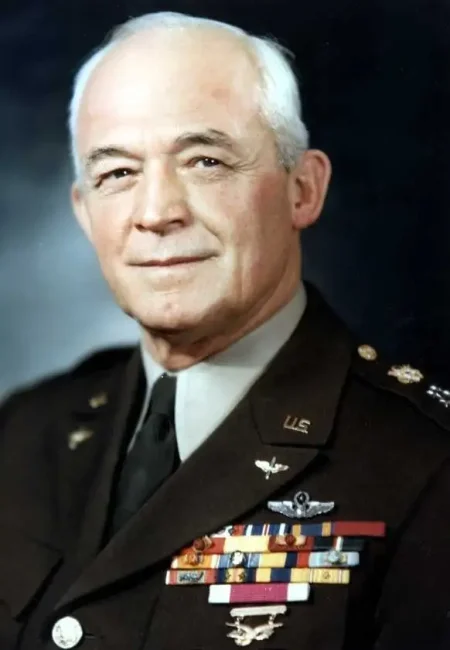- Military History
- Biographies
- Militarians Biographies
- General Henry Harley "Hap" Arnold
General Henry Harley "Hap" Arnold
General Arnold was instrumental in the creation of the U.S. Air Force
A native of Gladwyne, Pennsylvania, Arnold attended West Point, from which he graduated in 1907, and was commissioned an officer in the infantry. His first service was in the Philippines during 1907-1909, but he became passionately interested in flying and was a pioneer in military aviation.
He transferred to the aeronautical section of the Signal Corps in April 1911 and received flight instruction from the Wright brothers themselves that June. A natural flier, Arnold won the Mackay Trophy for successfully completing the first reconnaissance flight in a heavier-than-air craft in October 1912.
Despite the efforts of Arnold and other military aviation enthusiasts, the army had little faith in the airplane, and Arnold, disappointed and disgusted, returned to the infantry in April 1913. Three years later, however, he was returned to the air service, where, promoted to captain in May 1916, he supervised the army's aviation training schools when the United States entered World War I. He functioned in this capacity from May 1917 through 1919.
Despite sharp reductions in military funding during the years 1919-28, Arnold continued to work toward developing the Army Air Corps. He was sent to the army's Command and General Staff school, from which he graduated in 1929 with the rank of lieutenant colonel. In 1931, he was given command of the First Bomb Wing and the First Pursuit Wing at March Field, California, a post he held through February 1935. During July and August 1934, he led a flight of ten B-10 bombers on a round trip from Washington, D.C., to Fairbanks, Alaska, winning a second Mackay Trophy for his demonstration of the endurance of the modern bomber.
Promoted to brigadier general, Arnold took command of First Wing, GHQ Air Force, in February 1935, and became assistant chief of staff of the Air Corps in December of that year. With the death of General Oscar Westover in September 1938, Arnold was given a temporary promotion to major general and named chief of staff. He acted vigorously from this position to improve the combat readiness of the Air Corps but was severely hampered by a shortage of funds and a lingering reluctance by military planners to develop a fully effective air force.
In recognition of his effective advocacy of air power, Arnold became acting deputy chief of staff of the Army for air matters in October 1940, and chief of the Air Corps after it was renamed the U.S. Army Air Forces in June 1941. This position carried with it a temporary promotion to lieutenant general, conferred shortly after the bombing of Pearl Harbor and America's entry into World War II.
In March 1942, Arnold was named commanding general of Army Air Forces, and the following year was given the temporary rank of general. Arnold served on the U.S. Joint Chiefs of Staff, playing a key role in shaping Allied strategy in the European and Pacific theaters. He organized the 20th Air Force in April 1944, to bomb Japan. The 20th answered directly to his command as a representative of the Joint Chiefs. This was a significant step, since it took the Army Air Forces closer to becoming an independent service.
In December 1944, with generals Dwight D. Eisenhower, Douglas MacArthur and George C. Marshall he was elevated to the rank of general of the Army. He continued to command the Army Air Forces through the end of the war, retiring in March 1946. On September 18,1947, thanks to the foundation Arnold had laid, the Army Air Forces became an independent service: the U.S. Air Force.
In recognition of the role he played, Arnold, in retirement, was named first general of the Air Force in May 1949. He died the following year on his ranch in Sonoma, California.
General Henry Harley "Hap" Arnold - Quick Facts
- 1st Bombardment Wing (United States)
- 20th Air Force (United States)
- United States Airforce
- United States Army
- United States Army Air Forces
- WWI (1914-1918)
- WWII (1939-1945)
- {{#owner}}
- {{#url}} {{#avatarSrc}}
{{name}} {{/url}} {{^url}} {{#avatar}} {{& avatar}} {{/avatar}} {{name}} {{/url}} - {{/owner}} {{#created}}
- {{created}} {{/created}}
























